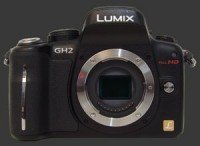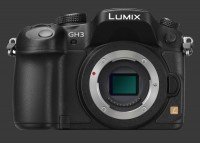Panasonic Lumix DMC-GH3 Review
Panasonic Lumix DMC-GH3 Performance - How well does it take pictures?
Performance starts with image quality, which is the criteria used as the foundation of our digital camera ratings. Ergonomic issues may get in the way, but in the end, image quality counts the most. For an ILC, image quality greatly depends on the lens used. While color, noise, exposure and dynamic-range are properties of a camera, distortion, vignetting and chromatic aberrations are properties of the lens. Sharpness and contrast depend on the weakest link. That is, a camera cannot capture more details than a lens lets through. Conversely, it is quite possible for a lens to transmit more details than a sensor can capture.
Image Noise & Details
The Panasonic Lumix DMC-GH3 turns in an impressive performance when it comes to image noise. Without a doubt, this is the best output seen to date from a Panasonic camera. Images remain noise-free until ISO 400 and miniscule speckles of noise appear at ISO 800, just enough to be detected without affecting the maximum print size. With its 16 megapixels, it can produce sharp and crisp 20" x 15" prints.
There is a slight amount of visible noise at ISO 1600 which stills allows for nice large prints. ISO 3200 shows a little more noise, reducing the maximum print size by a few inches, yet remaining usable for mid-sized prints. At ISO 3200, noise is readily apparent. However, it has surprisingly little impact on small details, making it suitable for common print-sizes.
By ISO 6400, fine details get moderately affected by image-noise. Mid-sized prints are sill possible which is an excellent performance for any digital camera. ISO 12800 is considerably more noisy and ISO 25600 even more. Even small prints are noisy at that point, yet they are still usable and show a recognizable subject with relatively good color and contrast.

Noise-reduction is adjustable ±5 along an arbitrary scale, where the default setting of 0 is damaging to details at all sensitivities. The best results are obtained at -3 which shows little difference in image-noise at low ISOs. From ISO 800 onwards, higher NR settings can hide noise but they do even more damage to image details.
Sharpness is adjustable on a ±5 scale as well. The default of 0 is visibly soft and lower levels are unusable. Higher levels get progressively sharper with +2 giving sharp images with virtually no sharpening artifacts.
Color & White Balance
Color accuracy is generally good. The Standard film mode produces the most realistic colors with a slight mix of over and under-saturation depending on the hue. While a little worse than average, this is suitable for non color-critical images. Otherwise, one should be able to obtain highly accurate colors by shooting RAW.
Automatic White-Balance has improved compared to previous generations but remains far from perfect. While it is capable of nailing WB under all sorts of conditions, the Panasonic GH3 produces slightly inconsistent results indoors and outdoors. The Custom WB option fairs much better but occasionally still leaves a slight cast.
Exposure & Dynamic-Range
The multi-segment metering system of the Panasonic GH3 is quite good. It is not entirely conservative and will often blow small highlights. This is a more consumer-oriented approach but requires negative EC from time-to-time to avoid clipping. Since it is tuned to produce bright images, positive EC is rarely needed.
Dynamic-range of the GH3 is comparable to the best Micro Four-Thirds cameras. This puts it one-to-two stops behind cameras with APS-Cs. This is a matter of physics since an equal resolution APS-C sensor must have larger photosites than a Four-Thirds one. Still, the GH3 is capable of capturing scenes having a wide dynamic-range.

Auto Focus
The GH3 keeps the ultra-fast Contrast-Detect AF system of the GH2. It locks focus quickly and accurately under most circumstances. This mirrorless rarely takes more than ½s to lock focus and, in good to moderate light, it takes closer to a ¼s. This excellent performance closely matches other top-of-the-line mirrorless cameras.
To speed things up Panasonic borrowed a trick from Sony and added their own technology to it. Optionally, the Eye-Start sensor can trigger autofocus before the shutter is pressed half-way. This brings the lens much closer to where it should be when its time to autofocus but quickly drains the battery, particularly when the camera is dangling from your neck and the Eye-Start sensor constantly detects proximity. Panasonic added a system to reduce premature focusing be measuring camera jitter. When jitter goes down, such as when a photographer is preparing to take a shot, the camera automatically triggers AF. Quite ingenious!
Speed
The Panasonic Lumix DMC-GH3 is very fast and responsive. The camera responds almost immediately to dials and buttons. The processor in this camera is obviously faster than previous models and delivers a performance which is must closer to that of a DSLR. Critically, the EVF/LCD lag is finally so minimal that operations feel more instantaneous.
The GH3's performance is characterized by these measurements:
- Power-On: ¾ second. Good.
- Power-On to First-Shot: 1¼s seconds. Good.
- Autofocus: ¼ - ½s. Closer to ¼ with Quick AF enabled and in good light. Excellent.
- Shutter-lag: Nearly instant with less than ½s blackout. Above average.
- Shot-to-shot: Just above 1s. Below average.
- Playback: ¼s to enter, ¾s to exit. Average.
- Power-Off: 2¼ seconds. Below average.
The autofocus speed and shutter-lag are clearly what is important which is where the GH3 does best. The only weak area is shot-to-shot speed which is slightly slower than on the GH2. Oddly, the delay between the first and second shot in a row is always longer which extends the black-out-time up to 1s. This still occurs Instant Review OFF and in MF focus with a fast shutter-speed. The result is that it is preferable to shoot moving subjects in continuous mode.
The Panasonic Lumix DMC-GH3 is powered by a proprietary Lithium-Ion battery which provides 540 shots-per-charge according to the CIPA standard. This is significantly above average for a mirrorless camera.
Panasonic Lumix DMC-GH3 Performance - How well does it shoot video?
The Panasonic GH3 certainly offers the most sophisticated video feature-set of any digital camera to date. This is important because mirrorless cameras offer superior image quality and versatility compared to camcorders. While video cameras still offer much more video-centric features, the GH3 brings plenty of features needed by videographers.
Just like image-quality, video-quality is made up of several aspects. The headline metric is resolution of which 1080p is the highest for HD video. The GH3 can shoot 1920x1080 video at up to 60 FPS in progressive mode, meaning that all frames are recorded in their entirety. Lower frame-rates and resolutions are available, down to 640x480 @ 30 FPS. For HD video, 30 FPS, 24 FPS and 60 interlaced FPS are also supported.
With frame-rates up to 60 FPS, the Panasonic GH3 can which render motion more smoothly than the usual 30 FPS HD video offered by most digital cameras. This creates files which are obviously heavier and require more processing power to play.
The Panasonic Lumix DMC-GH3 is probably the first camera to offer so many video encodings. It can use any of 3 codecs: AVCHD, MPEG-4 and H.264 with the latter packaged in a Quicktime file. Each codecs gives access to different video-quality options:
| Frame-Rate Resolution |
60 FPS Progressive |
60 FPS Interlaced |
30 FPS Progressive |
24 FPS Progressive |
|---|---|---|---|---|
| 1920x1080 | AVCHD 28 Mbps Quicktime 50 Mbps |
AVCHD 17 Mbps | Quicktime 72 Mbps AI Quicktime 50 Mbps AVCHD 24 Mbps MPEG-4 20 Mbps |
Quicktime 72 Mbps AI Quicktime 50 Mbps AVCHD 24 Mbps |
| 1280x720 | Quicktime 72 Mbps AI | MPEG-4 10 Mbps | ||
| 640x480 | MPEG-4 4 Mbps |
The bit-rate, measured in megabits-per-second runs from 4 to 72 Mbps. Higher numbers usually signify more details and larger files. For the top HD resolution, there is a span of 17 to 72 Mbps. Quicktime encodings come in to variants, the standard and the All-Intra (AI) one. With the former, as with AVCHD and MPEG-4, most frames are encoded incrementally in relation to entirely encoded ones. With AI, all frames are encoded in their entirely. This is less space efficient but makes it much easier to do editing operations.
Interestingly Panasonic chose bit-rates which are not necessarily proportional to resolution and frame-rate. In particular, 1080p at 30 FPS and 24 FPS are both encoded as 24 Mbps in AVCHD format and so are 1080p at 30 FPS, 1080p @ 24 FPS and 720p at 60 FPS! Since the slower 24 FPS rate has the same bit-rate as the 30 FPS one, it stands to be that the former will have fewer compression artifacts.

Video quality of the GH3 is exceptionally good when using one of the high bit-rate formats. Motions are rendered very smoothly when shooting at 60 FPS, which makes panning and zooming much more pleasant to view. This digital camera offers full manual-controls over video capture. When left in automatic or semi-automatic mode, it does an excellent job at adapting exposure to the changing scene.
Fine details and colors are well captured with little compression artifacts. In the presence of fast motion, some artifacts become noticeable but less so than usual at high bit-rates. Note though than an All-Intra encoding can often be of lower video-quality than a typical one of a lesser bit-rate. This depends on the scene but scenes with less movement favors typical encodings.
Crucially for the GH3, it can start and stop video-capture instantly in Movie mode. There is no point using other modes since the preview does not show framing correctly anyway unless one sets up the camera to not show image framing correctly.
Focus can be single-shot, continuous or manual for filming. AF-C keeps up quite well with small movements. Still, there is a chance that the camera might focus on the wrong subject, so it is best to focus manually. Using one of Panasonic's HD lenses makes this possible to do so quietly enough. Note that with the focus-switch to AF-S, the camera still focuses continuously while filming unless that is disabled in the Video menu.
Audio capture is possible via a built-in stereo microphone or an external sound source. The built-in microphone can be adjusted in 20 steps and features an optional wind-filter. As audio is being picked up by the GH3, it can be played back on a headset connected via a mini-jack input. The playback audio can come directly or from the recorded audio track to account for clipping and compression.
This camera can output video directly at 1080p via a mini-HDMI port. It can do so with or without overlay, making it possible to capture video using an external device. The GH3 can also embed Time-Code into videos as they are recorded. The Time-Code can start anew for each video or continuously run.
Panasonic Lumix DMC-GH3 Conclusion

The Panasonic Lumix DMC-GH3 is a significant upgrade to the GH2
Panasonic Lumix DMC-GH2 which precedes it in name. While there is a resemblance, the GH3 is considerably more. Even the sensor, which has the same size and resolution, outputs superior images with much lower noise, higher maximum sensitivity and faster continuous drive. The camera is now weather-sealed and features three control-dials, compared to one on the GH2, making it more suitable for advanced users.
The GH3 is very features-rich. Panasonic fit it with a considerable amount of functionality with an emphasis on video that is class-leading. A choice of 3 codecs, including All-Intra encodings up to 1920x1080 @ 30 FPS, plus clean 1080p HDMI output make it particularly appealing to videographers which will also be pleased with video manual-controls, adjustable audio levels, mini-jack stereo input and output.
Image quality from the GH3 is top-notch for its sensor-size. Image-noise is comparable to an entry-level DSLR while dynamic-range is just over one stop behind recent APS-C cameras. Metering, color and white-balance are not perfect but certainly good. This camera is generally quick fast and always remains responsive. Its autofocus system is particularly impressive and manages to lock quickly and reliable under most conditions.
The 1.7 MP EVF is large, sharp and shows very little lag. This gives the GH3 the ability to access all functionality and shoot video at eye-level. Too bad there is no way to make it Exposure-Priority outside of Manual mode. The LCD is very nice too with good visibility.
It is important to know that the Panasonic GH3 does not compete with most mirrorless cameras due to its size. What it offers is the advantages of a Live-View camera with DSLR-like image quality. This proposition is going to make the most sense for videographers looking for high-quality output with a cinematographic feel and the versatility of interchangeable lenses.
 |
Please Support Neocamera
All information on Neocamera is provided free of charge yet running this website is a huge endeavor. Purchases made via affiliate links found throughout the site help keep it running and up-to-date. There is no additional cost to you, so please consider buying via these links to our affilates:
If you found any information on this site valuable and did not purchase via our affiliate links, please considering donating via PayPal:
Any amount will be greatly appreaciated. Thank you for your support!
Panasonic DMC-GH3 Highlights

Sensor-Size: 17 x 13mm

Actual size when viewed at 100 DPI
| 16 Megapixels Mirrorless | ISO 125-25600 |
| Micro Four-Thirds Mount 2X FLM | Shutter 1/4000-60s |
| 0.50" Built-in EVF 1.7 Megapixels (0.67X) | Full manual controls, including Manual Focus |
| Automatic Eye-Start sensor | Custom white-balance with 2 axis fine-tuning |
| 2 Axis Digital Level | Spot-Metering |
| Weatherproof | Hot-Shoe & Sync-Port |
| Built-in Dust Reduction | Stereo audio input |
| 6 FPS Drive, Unlimited Images | Lithium-Ion Battery |
| 1920x1080 @ 60 FPS Video Recording | Secure Digital Extended Capacity |
| 3" LCD 610K Pixels |
Updates
2025.01.18

Fujifilm GFX 2025 Lens Roundup
Lens Review roundup of Fujifilm GFX Medium-Format lenses. Quality, performance and handling of the GF20-35mm F/4R WR, GF30mm F/3.5 Tilt-Shift and the GF55mm F/1.7.
2024.11.18

Best 2024 Photography Gifts for Every Budget
Great gifts for photographers and photo enthusiasts selected for every budget among the best products of 2024.
2024.08.07

Eye Protection Tips for Professional Photographers
The four main considerations for professional photographers regarding eyewear.
2024.07.14

Fujifilm X100VI Review
Flagship fixed-lens compact digital camera with a 40 MP sensor and Image-Stabilization, a first for the series. Retro design featuring dual control-dials, plus direct ISO, Shutter-Speed and EC dials. Its hybrid viewfinder can switch between EVF and OVF mode.
2024.05.09

Fujifilm GFX100 II Review
Flagship 102 Megapixels Medium-Format Mirrorless Digital Camera with 8-Stop 5-Axis IBIS, 8 FPS Drive, 8K Video and 400 MP Super-Resolution capture in a weatherproof and freezeproof body with dual control-dials and dual memory-card slots.
2024.04.03

Fujifilm X-T5 Review
Newest Fujifilm flagship boasting a 40 MP APS-C sensor, 5-axis IBIS with 7-stop efficiency, 15 FPS continuous drive, 6.2K Video capture, dual control-dials and dual SDXC UHS-II slots in a sturdy weatherproof and freezeproof body.
2023.11.20

Best Digital Cameras of 2023
Find out which are the Best Digital Cameras of 2023. All the new Mirrorless Digital Cameras from entry-level to high-end professional.
2023.07.10

Fujifilm X-H2 Review
40 Megapixels APS-C Hybrid Mirrorless Digital Camera with 7-stop IBIS. Fastest shutter ever and 8K video capture. Large builtin EVF with 0.8X magnification and 5.8 MP, plus an Eye-Start Sensor. Packed with features and large number of controls in a weatherproof and freezeproof body.
2023.05.07

Sony FE 20-70mm F/4G Review
Review of the unique Sony FE 20-70mm F/4G lens. The optical zoom of this lens spans ultra-wide-angle and medium focal-length coverage, making it one of the most versatile Full-Frame lenses on the market.
2023.01.15

Huion Inspiroy Dial 2 Review
Review of the Huion Inspiroy Dial 2 tablet, a medium sized drawing surface with dual dials and customizable buttons. Connects via USB-C or Bluetooth 5.0 with Windows, Linux and Android support.
2022.12.08

How to Pack for a Photo Trip
Find out how to pack for a travel photography trip, carry your gear safely while meeting airline regulations.
2022.11.13

Best Digital Cameras of 2022
The best digital cameras of 2022. A short list of the most outstanding models in their respective categories. Choose one for yourself or as a gift.












